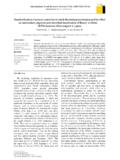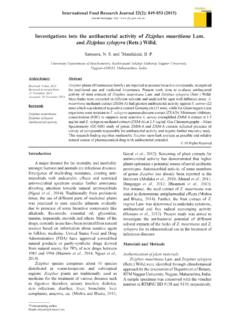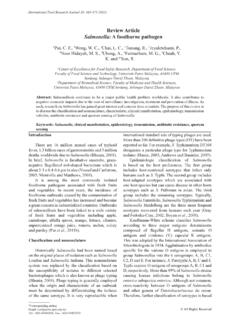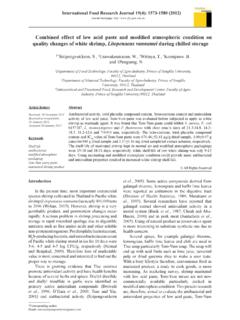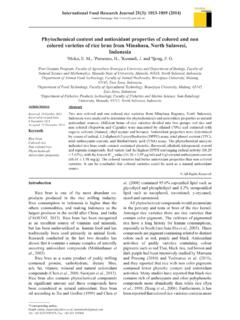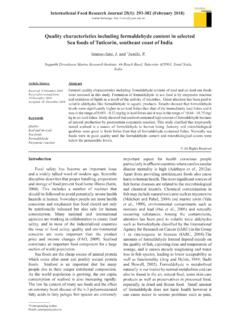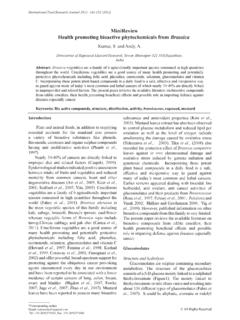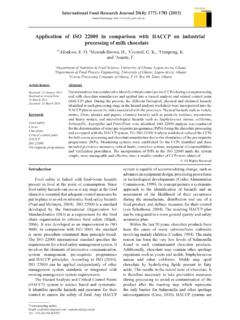Transcription of Enhancement of the properties of biodegradable …
1 All Rights Reserved*Corresponding author. Email: +66 74 286 359; Fax: +66 558866 International Food Research Journal 21(3): 1225-1235 (2014)Journal homepage: , N., Sridach, W. and *Wittaya, of Material Product Technology, Faculty of Agro-Industry, Prince of Songkla University, Hat Yai, Songkhla, 90112, ThailandEnhancement of the properties of biodegradable rice starch films by using chemical crosslinking agentsAbstractThe effect of chemical crosslinking on the mechanical, thermal properties and water vapor permeability of rice starch-based films were investigated. Epichlorohydrin (EPI), Sodium trimetaphosphate (STMP) and the mixing of STMP/STPP (Sodium tripolyphosphate) were used as crosslinking agents. The viscosity of crosslinked rice starch decreased when the content of the crosslinking agent increased concomitant with the increasing of the pasting temperature. The results showed that the degree of crosslinking increased when the content of the cross-linking agents increased.
2 The tensile strength of rice starch films increased concomitantly with decreases in elongation at break and water vapor permeability when chemical-crosslinking was applied. In addition, the crosslinking reaction decreased the crystalline peak structure and percentage of crystallinity of rice starch films. The rice starch films were characterized by Fourier Transform infrared spectroscopy (FT-IR) and this confirmed that crosslinking between starches molecules had occurred. The behavior of thermal properties of crosslinked rice starch films were investigated by means of dynamic mechanical thermal analysis (DMTA) and using a differential scanning calorimeter (DSC). It was found that the glass temperature (Tg) of crosslinked rice starch films shifted to a higher temperature than that of untreated rice starch films. In addition, the storage modulus (E ) of crosslinked rice starch films decreased twice as much as untreated rice starch films, while the tan d curve of crosslinked rice starch film was higher than that of untreated rice starch films.
3 IntroductionRecently, environmentally friendly materials from natural and renewable resources have received much attention (Ma et al., 2004; Nakamura et al., 2005; Xiong et al., 2008). The development of innovative materials as substitutes for synthetic polymers has become an important challenge. Among these materials are biopolymers from vegetable or animal proteins (Arvanitoyannis, 2006; Xiong et al., 2008). Since 1970s there been much study of polar polymers or biopolymer such as polysaccharide and protein. Both of them are new alternative materials for use instead of synthetic polymers in plastic and plastic film manufacturing in the light of environmental problems (Garcia et al., 2000).Many researchers have found that the property of biopolymer such as polysaccharide, protein and fat can be formed into film and coating. Technically, biopolymer consists of naturally occurring polymers that are found in renewable resources.
4 Using biopolymers will cause less harmful to our environment compared to the use of fossil fuel based commodity plastics. Basically, biopolymers can be degraded by the enzymatic action of living organisms. These processes involve bacteria, yeasts, fungi and the ultimate end-products of the degradation process. These are CO2, H2O and biomass under aerobic conditions and hydrocarbons, methane and biomass under anaerobic conditions (Gerngross et al., 2003).Starches used in industrial applications are usually extracted from cereal seeds (corn, wheat, and rice), tubers (potato), and roots (tapioca) (Chiou et al., 2005). Starch has been investigated widely for the potential manufacture of products such as water-soluble pouches for detergents and insecticides, flushable liners and bags, and medical delivery systems and devices. Starch granular organization as well as its amylose and amylopectin structure depends on the botanical source.
5 It is an abundant raw material with low cost, and has been applied in the area of degradable plastics. Blend films containing starch are potential materials in the agriculture, medicine, and the packaging industries (Funke et al., 1998; Hulleman et al., 1998; Lu et al., 2005; Xiong et al., 2008).Rice is the seed of the monocot plants Oryza sativa or Oryza glaberrima. It has many important roles in Thai society from food to work. Rice uses over half of the cultivable land area and labor force in KeywordsCrosslinking agentsRice starch films Mechanical properties Barrier propertiesThermal propertiesArticle historyReceived: 1 May 2013 Received in revised form: 19 January 2014 Accepted: 20 January 20141226 Detduangchan et 21(3): 1225-1235 Thailand. On the other hand, rice starch contains high amylose which is attractive raw materials for use as barriers in packaging materials. Rice starches have been used to produce biodegradable films to partially or entirely replace plastic polymers because of their low cost and renewability.
6 They also possess good mechanical properties (Xu et al., 2005; Bourtoom and Chinnan, 2008). However, the wide application of starch film is limited by their mechanical weaknesses and the fact that they are swollen by water depending on the relative humidity (RH) (Seow et al., 1999).Chemical modifications such as grafting or crosslinking are able to limit excessive water swelling and macromolecular motion. Basically, cross-linking means that the polymer molecules are interconnected by some sort of bonding. The bonding can be covalent, ionic, or it can result from intermolecular forces such as hydrogen bonding. The crosslink density in materials is necessary for the assessment of the quality of cross-linked polymers. In addition, the optimization of curing conditions and the tailored design of new products with improved mechanical and aging properties are important. The physical structure of cross-linked polymers, their network dynamics and molecular mobility, depend to a large extend on the density of crosslinks.
7 Mechanical and oxidative aging as well as the different types and amounts of fillers affect the network dynamics, and these may lead to a change of crosslink density and/or to a degradation of the chemical structure by hydrocarbon chain scissions (Kuhn et al., 2006). In addition, crosslinking tends to limit the interaction of starch with water and provides a structural integrity to starch based biodegradable materials during exposure to pressure and moisture (El-Tahlawy et al., 2007). Classical crosslinking leads to the modified starches used in food or paper additive applications in which crosslinking occurs in heterogeneous media using dry or semi-dry blending processes. For example, starch networks are usually achieved by treating granular starch with the following crosslinking agents in different media: sodium trimetaphosphate (STMP) (Woo and Seib, 1997); epichlorohydrin (EPI) (Kuniak and Marchessault, 1973); and a mixture of sodium trimetaphosphate (STMP) / Sodium tripolyphosphate (STPP).
8 In this study the properties of rice starch films were improved by chemical treatment, using crosslinking agents such as STMP, EPI and a STMP/STPP mixture. In addition, the properties of crosslinked rice starch and rice starch films gained from chemical treatment were also investigated by comparing the viscosity, pasting temperature, degree of cross-linking, mechanical property, thermal property and structural and MethodsMaterialsRice starch was extracted from grains of Chiang Phatthalung rice (Oryza sativa L.) by using alkaline methods, and the rice grain was purchased from a local grocery. It contained amylose and moisture content of about and (determined in triplicate by vacuum drying at 70 C for 24 h using the EYELATM, Model VOS-300VD, Japan), respectively. Commercial grade sorbitol, used as a plasticizer, was purchased from the Vidyasom Co. Ltd. (Thailand). The crosslinking reagents used were Epichlorohydrin (EPI), which was purchased from MERCK Schuchardt OHG (Hohenbrunn, Germany), Sodium trimetaphosphate (STMP)m whichwas obtained from SciencePedia Co.
9 , Ltd. (Bangkae, Bangkok), and Sodium tripolyphosphate (STPP), which was purchased from SIGMA-ALDRICH Co., (St. Louis, MO, USA). Preparation of cross-linked rice starchRice starch was modified by using 3 types of cross-linking agent. Crosslinked rice starch with Epichlorohydrin (EPI) was prepared by using the methodology of Wurtzburg (1960) and Wattanachant et al. (2003). Fifteen gram of sodium chloride was added to 250 ml of distilled water. After the salt was dissolved, 100 g of rice starch were added and stirred until the mixture was uniform. Then 5% of sodium hydroxide solution was added to adjust the slurry to pH with vigorous stirring to prevent starch gelatinization. The crosslinking agent at , and of EPI was added into the mixture and stirred at room temperature for 5 h. After that the 1% of hydrochloric acid solution was added into slurry to terminate the reaction by adjusting the slurry to pH Starch slurry was washed with water and neutralized with 5% NaOH.
10 The slurry obtained was centrifuged at 8000 rpm for 15 min; thereafter the starch was dried at 50 C for 24 h. Crosslinked starch with sodium trimetaphosphate (STMP) and mixtures of sodium trimetaphosphate/Sodium tripolyphosphate (STMP/STPP: 99/1 w/w) was prepared according to the method of Woo and Seib (2002) and Koo et al. (2010). Native rice starch granules weighing 100 g were added to 250 ml of distilled water. Then, the cross-linking agents, STMP ( , and ) and STMP/STPP ( , and ), were added to the slurry. The mixtures were adjusted to pH by 5% NaOH. The slurries were Detduangchan et 21(3): 1225-12351227stirred continuously and warmed up to 45 C for 1 h. Later, 1 g/1000 ml of hydrochloric acid solution was added into slurry to terminate the reaction by adjusting the slurry to pH Starch slurry was washed with water and neutralized with 5% NaOH. The slurry obtained was centrifuged at 8000 rpm for 15 min; thereafter the starch was dried at 50 C for 24 h.
